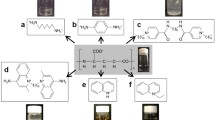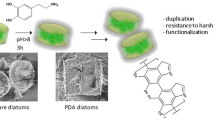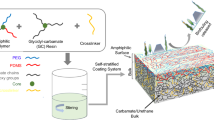Abstract
Thermostable polymers cast as thin, porous coatings or membranes may be useful for concentrating and stabilizing hyperthermophilic microorganisms as biocatalysts. Hydrogel matricies can be unstable above 65°C. Therefore a 55-μm thick, two layer (cell coat + polymer top coat) bimodal, adhesive latex coating of partially coalesced polystyrene particles was investigated at 80°C using Thermotoga maritima as a model hyperthermophile. Coating permeability (pore structure) was critical for maintaining T. maritima viability. The permeability of bimodal coatings generated from 0.8 v/v of a suspension of non-film-forming 800 nm polystyrene particles with high glass transition temperature (Tg= 94°C, 26.9% total solids) blended with 0.2 v/v of a suspension of film-forming 158 nm polyacrylate/styrene particles (Tg≈ −5°C, 40.9% total solids) with 0.3 g sucrose/g latex was measured in a KNO3 diffusion cell. Diffusivity ratio remained above 0.04 (Deff/D) when incubated at 80°C in artificial seawater (ASW) for 5 days. KNO3 permeability was corroborated by cryogenic-SEM images of the pore structure. In contrast, the permeability of a mono-dispersed acrylate/vinyl acetate latex Rovace SF091 (Tg~10°C) rapidly decreased and became impermeable after 2 days incubation in ASW at 80°C. Thermotoga maritima were entrapped in these coatings at a cell density of 49 g cell wet weight/liter of coating volume, 25-fold higher than the density in liquid culture. Viable T. maritima were released from single-layer coatings at 80°C but accurate measurement of the percentage of viable entrapped cells by plate counting was not successful. Metabolic activity could be measured in bilayer coatings by utilization of glucose and maltose, which was identical for latex-entrapped and suspended cells. Starch was hydrolyzed for 200 h by latex-entrapped cells due to the slow diffusion of starch through the polymer top coat compared to only 24 h by suspended T. maritima. The observed reactivity and stability of these coatings was surprising since cryo-SEM images suggested that the smaller low Tg polyacrylate/styrene particles preferentially bound to the T. maritima toga-sheath during coat formation. This model system may be useful for concentrating, entrapment and stabilization of metabolically active hyperthermophiles at 80°C.









Similar content being viewed by others
Abbreviations
- ASW:
-
Artificial seawater
- Deff/D:
-
Ratio of the diffusivity of KNO3 in a latex coating relative to its diffusivity, D, in water
- T g :
-
Polymer particle glass transition temperature
- v/v:
-
Volume fraction of bimodal latex emulsions blended
References
Adams MWW (1995) Large-scale growth of hyperthermophiles. In: Robb FT, Place AR, Sowers KR, Schrier HJ, DasSarma S, Fleischmann EM (eds) Archaea: a laboratory manual. Cold Spring Harbor, New York, pp 47–49
Brown SH, Sjrholm C, Kelly RM (1993) Purification and characterization of a highly stable glucose isomerase produced by the extremely thermophilic eubacterium, Thermotoga maritima. Biotechnol Bioeng 41:878–886
Cabral JB, Mota M, Tramper J (2001) Multiphase bioreactor design. Tayor & Francis, London
Cantwell JB, Mills PDA, Jones E, Stewart RF (1995) Immobilized cells. European Patent Office 0288203B1
Charaniya SP (2004) Optimization of the catalytic activity of bilayer latex coatings for bacterial whole-cell oxidation and reduction. MS Thesis, University of Minnesota
Chhabra SR, Shockley KR, Conners SB, Scott KL, Wolfinger RD, Kelly RM (2003) Carbohydrate-induced differential gene expression patterns in the hyperthermophilic bacterium Thermotoga maritima. J Biol Chem 278:7540–7552
Cussler EL (1998) Diffusion: mass transfer in fluid systems, 2nd edn. Cambridge University Press, Cambridge, pp 22–24
De Rosa M, Gambacorta A, Lama L, Nicolaus B (1981) Immobilization of thermophilic microbial cells in crude egg white. Biotechnol Lett 3:183–186
Di Lernia I, Schiraldi C, Generoso M, De Rosa M (2002) Trehalose production at high temperature exploiting an immobilized cell bioreactor. Extremophiles 6:341–347
Dos Santos FD, Fabre P, Drujon X, Meunier G, Leibler L (2000) Films from soft-core/hard-shell hydrophobic latexes: structure and thermomechanical properties. J Polymer Sci B 38:2989–3000
Drioli E, Giorno L (1999) Biocatalytic membrane reactors. Taylor & Francis, London
Geankoplis CJ (1984) Mass transport phenomena. Edward Brothers, Columbus
Gebhard MS, Lesko PM, Brown AB, Young DH (2004) Porous non-friable polymer films. US Patent 6,750,050
Hicks PM, Kelly RM (1999) Thermophilic microorganisms. In: Flickinger MC, Drew SW (eds) Encyclopedia of bioprocess technology: fermentation, biocatalysis, and bioseparation. Wiley Interscience, New York, pp 2536–2552
Holst O, Manelius Å, Krahe M, Märkl H, Raven N, Sharp R (1997) Thermophiles and fermentation technology. Comp Biochem Physiol 118A:415–422
Huang Z, Thiagarajan V, Lyngberg OK, Scriven LE, Flickinger MC (1999) Microstructure evolution in polymer latex coatings for whole-cell biocatalyst applications. J Coll Interface Sci 215:226–243
Jons S, Ries P, McDonald CJ (1999) Porous latex composite membranes: fabrication and properties. J Membr Sci 155:79–99
Kalinina O, Kumacheva E (1999) A “core-shell” approach to producing 3D polymer nanocomposites. Macromolecules 32:4122–4129
Kester DR, Duedall IW, Connors DN, Pyrkowicz RM (1967) Preparation of artificial sea water. Limnol Oceanogr 12:176–178
Liebl W, Stemplinger I, Ruile P (1997) Properties and gene structure of the Thermotoga maritima α-amylase AmyA, a putative lipoprotein of a hyperthermophilic bacterium. J Bacteriol 179:941–948
Lyngberg OK, Thiagaragan V, Stemke DJ, Schottel JL, Scriven LE, Flickinger MC (1999a) A patch coating method for preparing biocatalytic films with E. coli. Biotechnol Bioeng 62:44–55
Lyngberg OK, Stemke DJ, Schottel JL, Flickinger MC (1999b) A simple single use luciferase based mercury biosensor using latex-film immobilized Escherichia coli HB101. J Ind Microbiol Biotechnol 23:668–676
Lyngberg OK, Ng CP, Thiagarajan V, Scriven LE, Flickinger MC (2001) Engineering the microstructure and permeability of thin multilayer latex biocatalytic coatings containing E. coli. Biotechnol Prog 17:1169–1179
Ma Y (2002) High-resolution cryo-scanning electron microscopy of latex film formation. PhD Thesis, University of Minnesota
Pantazaki AA, Pritsa AA, Kyriakidis DA (2002) Biologically relevant enzymes from Thermus thermophilus. Appl Microbiol Biotechnol 58:1–12
Park H-S, Kayser KJ, Kwak J-H, Kilbane JJ (2004) Heterologous gene expression in Thermus thermophilus: β-galactosidase, dibenzothiophene monooxygenase, PNB carboxy esterase, 2-aminobiphenyl-2,3-diol dioxygenase, and chloramphenicol acetyl transferase. J Ind Microbiol Biotechnol 31:189–197
Pörtner R, Märkl H (1996) Immobilization of the extremely thermophilic archaeon Pyrococcus furiosus in macro-porous carriers. In: Wijffels RH, Buitelaar RM, Bucke C, Tramper J (eds) Immobilized cells: basics and applications. Elsevier, Amsterdam, pp 424–430
Rainina EI, Pusheva MA, Ryabokon AM, Bolotina NP, Lozinsky VI, Varfolomeyev SD (1994) Microbial cells immobilized in poly(vinyl alcohol) cryogels: biocatalytic reduction of CO2 by the thermophilic homoacetogenic bacterium Acetogenium kiuvi Biotechnol Appl Biochem 19:321–329
Ryabokon AM, Kevbrina MV, Pusheva MA, Zubov AL, Lozinsky VI, Rainina EI (1996) Ecologically pure cultures of acetate synthesis on diverse gaseous substrates by homoacetogenic bacteria, entrapped in poly(vinyl alcohol) cryogel. In: Wijffels RH, Buitelaar RM, Bucke C, Tramper J (eds) Immobilized cells: basics and applications. Elsevier, Amsterdam, pp 106–111
Sanchez Marcano JG, Tsotsis TT (2002) Catalytic membranes and membrane reactors. Wiley-VCH, Weinheim, Germany
Schiraldi C, Di Lernia I, Giuliano M, Generoso M, D’ Agnostino A, De Rosa M (2003) Evaluation of a high temperature immobilized enzyme reactor for production of non-reducing oligosaccharides. J Ind Microbiol Biotechnol 30:302–307
Schröder C, Selig M, Schönheit P (1994) Glucose fermentation to acetate, CO2, and H2 in the anaerobic hyperthermophilic eubacterium Thermotoga maritima: involvement of the Embden-Mayerhof pathway. Arch Microbiol 161:460–470
Sharp RJ, Raven NDH (1997) Isolation and growth of hyperthermophiles. In: Rhodes PM, Standbury PF (eds) Applied microbial physiology. IRL, Oxford, pp 23–52
Singh A, Goel R, Johri BN (1990) Production of cellulolytic enzymes by immobilized Sporotrichium thermophile. Enz Microbiol Technol 12:464–468
Solheid C (2003) Characterization of bilayer latex coatings containing viable Gluconobacter oxydans for the oxidation of D-sorbitol to L-sorbose. MS Thesis, University of Minnesota
Swope KL, Flickinger MC (1996) Activation and regeneration of whole cell biocatalysts: initial and periodic induction behavior in starved E. coli after immobilization in thin synthetic films. Biotechnol Bioeng 51:360–370
Thiagarajan VS, Huang Z, Scriven LE, Schottel JL, Flickinger MC (1999) Microstructure of a biocatalytic latex coating containing viable Escherichia coli cells. J Coll Interface Sci 215:244–257
Tzitznou A, Keddie JL (2000) Film formation of latex blends with bimodal particle size distributions: consideration of particle deformability and continuity of the dispersed phase. Macromolecules 33:2695–2708
Tzitznou A, Keddie JL, Geurts JM, Peters ACIA, Satguru R (2000) Film formation of latex blends with bimodal particle size distributions: consideration of particle deformability and continuity of the dispersed phase. Macromol 33:2695–2708
Van de Ban E, Willemen H, Wassink H, Haaker H, Laane C (1998) Bioreductions by Pyrococcus furiosus at elevated temperature. In: Ballesteros A, Plou FJ, Iborra JL, Halling PJ (eds) Progress in biotechnology 15: stability and stabilization of biocatalysts. Elsevier, Amsterdam
Van Niel EWJ, Claassen PAM, Stams AJM (2003) Substrate and product inhibition of hydrogen production by the extreme thermophile Caldicellulosiruptor saccharolyticus. Biotechnol Bioeng 81:255–262
Van Ooteghem SA, Beer SK, Yue PC (2002) Hydrogen production by the thermophilic bacterium Thermotoga neapolitana. Appl Biochem Biotechnol 98–100:177–189
Webb C, Devakos GA (1996) Studies in viable cell immobilization. Academic Press, RG Landes Co, Austin
Wijffels RH (ed) (2001) Immobilized cells. Springer, Berlin
Worden RM, Subramanian R, Bly MJ, Winter S, Aronson CL (1991) Growth kinetics of Bacillus stearothermophilus BR219. Appl Biochem Biotechnol 28/29:267–275
Acknowledgements
The authors would like to thank Professor Robert M. Kelly, Tina D. Rinker, and Paula M. Hicks, North Carolina State University, Raleigh, North Carolina, for their assistance and encouragement in beginning this work, Sridevi Nagarajan for developing the anaerobic plate counting method, Erwin Sutanto for cryo-FESEM images of bimodal blend coatings, and Marcello Fidaleo for helpful comments on preparation of the manuscript. Latex polymers were generously supplied by Matthew Gebhard, Rohm and Haas, Co., Spring House, PA, USA. This work was supported by NIH grant T32/GM08347, DSO DARPA contract N66001-020C-8046, Joe Bielitski Program Director, and the University of Minnesota BioTechnology Institute.
Author information
Authors and Affiliations
Corresponding author
Additional information
Communicated by J. Wiegel
Rights and permissions
About this article
Cite this article
Lyngberg, O.K., Solheid, C., Charaniya, S. et al. Permeability and reactivity of Thermotoga maritima in latex bimodal blend coatings at 80°C: a model high temperature biocatalytic coating. Extremophiles 9, 197–207 (2005). https://doi.org/10.1007/s00792-005-0434-7
Received:
Accepted:
Published:
Issue Date:
DOI: https://doi.org/10.1007/s00792-005-0434-7




